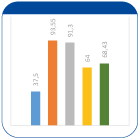Burden and types of support for family caregivers serving patients with chronic disease
DOI:
https://doi.org/10.15649/cuidarte.v10i3.649Keywords:
Patients, Caregivers, Chronic Disease, Social SupportAbstract
Introduction: An increase in chronic noncommunicable disease has been evidenced worldwide in this century; patients present with longer-lasting and more complex pathologies, generating dependence, requiring a caregiver at home; while different skills are required to improve care competencies. Objective: To identify types of support used by the family caregivers of patients with chronic noncommunicable disease and their relation with the caregivers’ burden. Materials and Methods: Quantitative-approach, cross-sectional and analytical study, applying these tools: "Characterization of the patient-caregiver dyad and Caregiver’s Zarit Burden Interview". The population comprised 62 dyads. OR were calculated in logistic regression. Results: 19.35% (12) of caregivers showed an intense level of burden, 20.97% (13) showed a light burden, and 59.68% (37) had no burden. Caregivers with intense burden state there is 0% of psychological and social support. The relevant variables in the burden level were daily hours of care OR = 1.14 (CI 95%: 1.01; 1.33), the higher the level of knowledge of the computer, the lower the possibility of increase in the level of burden with raw OR= 0.14 (CI95%: 0.02; 0.91), and adjusted OR = 0.07 (CI 95%: 0.007; 0.68). Discussion: It is critical to continue investigating aspects that will reduce the caregivers’ burden, keep them healthy and under appropriate conditions to perform their role. Conclusions: It is necessary to strengthen the different types of support for family caregivers to reduce the burden level related to their work.
References
Organización Mundial de la salud. Enfermedades Crónicas. Oficina Regional de la OMS; 2014.
Castañeda O, Segura O, Parra A. Prevalencia de enfermedades crónicas no trasmisibles, Trinidad-Casanare. Revista Médica Risaralda. 2018; 38-42.
Torres MDP, Ballesteros E, Sanchez D. Programas e intervenciones de apoyo a los cuidadores informales en España. Gerokomos. 2008; 9-15.
Carrillo G, Chaparro L, Sanchez B. Conocimiento y acceso a las TIC en personas con enfermedad crónica y cuidadores familiares en Colombia. Enfermeria Global. 2014; 123-34.
Campos de Aldana MS, Moya Plata D, Mendoza Matajira JD, Duran Niño EY. Las enfermedades crónicas no transmisibles y el uso de tecnologías de información y comunicación: revisión sistemática. Rev Cuid. 2014; 5(1): 661-9. https://doi.org/10.15649/cuidarte.v5i1.104
Sánchez B, Carrillo GM, Barrera L. Plan de Transición y egreso hospitalario y su efecto en el cuidado de la salud: una revisión integrada. Revista UDCA Actualidad y Divulgación Científica. 2014; 13-23.
Ortiz Y, Lindarte A, Jimenez M, Vega O. Características sociodemográficas asociadas a la sobrecarga de los cuidadores de pacientes diabéticos en Cúcuta. Rev Cuid. 2013; 4(1): 459-66. https://doi.org/10.15649/cuidarte.v4i1.5
Eterovic C, Mendoza S, Saez K. Habilidad de Cuidado y nivel de sobrecarga en cuidadoras/es informales de personas dependientes. Enfermeria Global. 2015; 235-48. https://doi.org/10.6018/eglobal.14.2.198121
Black C, Ritchie C, Khandker R, Wood R, Jones E, Hu X, et al. Non-professional caregiver burden is associated with the severity of patients’ cognitive impairment. PLoS ONE. 2018; 13(12): e0204110. https://doi.org/10.1371/journal.pone.0204110
Carrilho P, Rodrigues M, Oliveira B, de-Silva E, da-Silva T, Schran L, et al. Profile of caregivers of Parkinson’s disease patients and burden measured by Zarit Scale Analysis of potential burden generating factors and their correlation with disease severity. Dementia & Neuropsychologia. 2018; 12(3): 299-305. https://doi.org/10.1590/1980-57642018dn12-030011
Duran M, Torres C, Arboleda L, Rivera R, Franco S, Santos J. Effectiveness of an Educational Nursing Intervention on Caring Ability and Burden in Family Caregivers of Patients with Chronic Non-Communicable Diseases. A Preventive Randomized Controlled Clinical. Invest. Educ. Enferm. 2019; 37(1): e04. https://doi.org/10.17533/udea.iee.v37n1e04
Romero S, Villamizar B, Rueda L. Apoyo telefónico: una estrategia de intervención para cuidadores familiares de personas con enfermedad crónica. Salud UIS. 2011; 191-201.
Carrillo G, Chaparro OL, Barrera L, Sánchez B, Pinto N. Soporte Social con el uso de las TIC's para cuidadores familiares de personas con enfermedad crónica. Revista de Salud Pública. 2011; 446-57.
Romero-Guevara S, Correa B, Camargo-Figuera F. Soporte Social percibido en cuidadores familiares de personas con enfermedad crónica. Univ. Salud. 2017; 19(1): 85-93. https://doi.org/10.22267/rus.171901.72
Gabriel I, Mayers P. Effects of a psychosocial intervention on the quality of life of primary caregivers of women with breast cancer. Eur J Oncol Nurs. 2019; 38: 85-91. https://doi.org/10.1016/j.ejon.2018.12.003
Dow B, Moore K, Scott P, Ratnayeke A, Wise K, Sims J, et al. Rural carers online: A feasibility study. Australian Journal of Rural Health. 2008; 16(4): 221-5. https://doi.org/10.1111/j.1440-1584.2008.00982.x
Crespo-Burillo J, Rivero-Celada D, Saenz-de Cabezon A, Casado-Pellejero J, Alberdi-Viñas J, Alarcia-Alejos R. Influencia de la estimulación cerebral profunda en la carga de cuidadores de pacientes con enfermedad de Parkinson. Neurologia. 2018; 33(3): 154-9. https://doi.org/10.1016/j.nrl.2016.05.017
Kang A, Yu Z, Foo M, Chan C, Griva K. Evaluating Burden and Quality of Life among Caregivers of Patients Receiving Peritoneal Dialysis. Peritoneal Dialysis International. 2019; 39(2): 176-80. https://doi.org/10.3747/pdi.2018.00049
Bachner Y, Morad M, Sroussi C, O’Rourke N. Direct and indirect predictors of burden among Bedouin caregivers of family members with terminal cancer in Israel. Aging & Mental Health. 2019; 1-7. https://doi.org/10.1080/13607863.2019.1570080
DePasquale N, Crain T, Buxton O, Zarit S, Almeida D. Tonight’s Sleep Predicts Tomorrow’s Fatigue: A Daily Diary Study of Long-Term Care Employees With Nonwork Caregiving Roles. The Gerontological Society of America. 2019; 20(20): 1-13. https://doi.org/10.1093/geront/gny176

Published
How to Cite
Issue
Section
Altmetrics
Downloads
License
Journal Cuidarte, scientific publication of open access, is licensed under a Creative Commons Attribution (CC BY-NC), which permits use, distribution and reproduction in any medium, provided the original work is properly cited and is not used for commercial purposes.
Any other form of use such as reproduction, transformation, public communication or distribution, for profit, requires the prior authorization of the University of Santander UDES.
The names and e-mail addresses entered in the Journal Cuidarte will be used exclusively for the purposes stated by this magazine and will not be available for any other purpose or other person.
The articles published in the Journal Cuidarte represent the criteria of their authors and do not necessarily constitute the official opinion of the University of Santander UDES.






